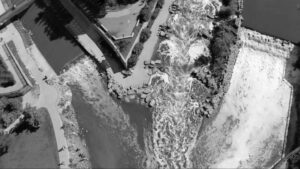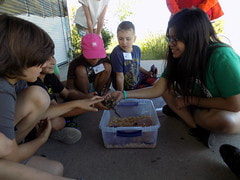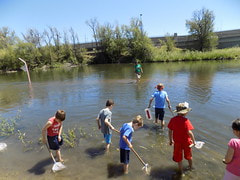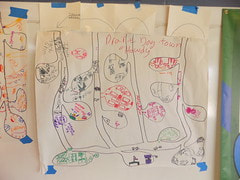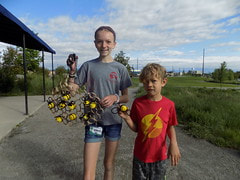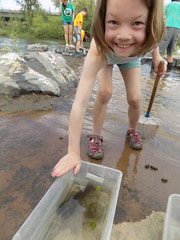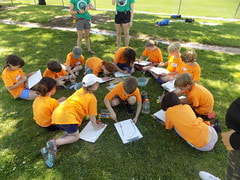Summer campers had a great time learning about many Colorado “Creepy Creatures” over the week of June 10-14! Whether you love creepy creatures or they give you the heebie-jeebies, these critters are a part of Colorado! Campers joined us for a week of learning about animals like spiders, bats, and snakes while we learned facts, dispelled myths, and found that they may be cool creatures after all!
Monday: Slimy Scaries
We kicked off the week with learning about some creatures that may be slimy and scary! But we discovered that not all of these creatures were slimy after all! Campers started by becoming Colorado snake experts. We learned about the many snakes that call Colorado home, analyzed shedded snake skin and talked about its importance to snakes, played some snake games, and even got to meet one of the River Ranger’s pet ball python that she brought in to say hello (and she wasn’t slimy at all!).
The next animals we learned about really were slimy! Leeches and worms are common in Colorado waterways and underground. We learned about some cool adaptations that these animal cousins have, discovered how they are both important in their ecosystems, and got to go into the River to try and catch some! (Leeches and aquatic worms can both be found in the South Platte!)
Monday: Slimy Scaries
We kicked off the week with learning about some creatures that may be slimy and scary! But we discovered that not all of these creatures were slimy after all! Campers started by becoming Colorado snake experts. We learned about the many snakes that call Colorado home, analyzed shedded snake skin and talked about its importance to snakes, played some snake games, and even got to meet one of the River Ranger’s pet ball python that she brought in to say hello (and she wasn’t slimy at all!).
The next animals we learned about really were slimy! Leeches and worms are common in Colorado waterways and underground. We learned about some cool adaptations that these animal cousins have, discovered how they are both important in their ecosystems, and got to go into the River to try and catch some! (Leeches and aquatic worms can both be found in the South Platte!)
Tuesday: Underground Engineers
There are many cool animals that live underground that are great excavators, diggers, architects, and engineers! First, we talked about a type of tiny engineer that is found nearly all over the world- ants! They can build huge and complex structures underground, just by instinct and communicating by pheremones! We painted our own underground ant structures as a craft after learning more about ant life cycles and the structures they build.
Next, we learned about prairie dogs and the underground towns that they construct! Like ants, they create many rooms, each with a different purpose. We drew our own prairie dog towns, learned about their adaptations, and played a survival game!
We wrapped up our day talking about how and why human engineers work and explained the steps that engineers take to solving a problem: Identify the Problem (What do we need to do? What is our goal?), Brainstorm (the most important step!), Design (blueprint), Build (may be a model version first), Test and Evaluate (Then may need to go back to step 4, until it is perfect and safe and ready-to-go!), and Share the Solution! Then, campers started brainstorming ideas for inventions of their own!
There are many cool animals that live underground that are great excavators, diggers, architects, and engineers! First, we talked about a type of tiny engineer that is found nearly all over the world- ants! They can build huge and complex structures underground, just by instinct and communicating by pheremones! We painted our own underground ant structures as a craft after learning more about ant life cycles and the structures they build.
Next, we learned about prairie dogs and the underground towns that they construct! Like ants, they create many rooms, each with a different purpose. We drew our own prairie dog towns, learned about their adaptations, and played a survival game!
We wrapped up our day talking about how and why human engineers work and explained the steps that engineers take to solving a problem: Identify the Problem (What do we need to do? What is our goal?), Brainstorm (the most important step!), Design (blueprint), Build (may be a model version first), Test and Evaluate (Then may need to go back to step 4, until it is perfect and safe and ready-to-go!), and Share the Solution! Then, campers started brainstorming ideas for inventions of their own!
Wednesday: Engineers of the Air
Birds are well known for their engineering skills and creativity when building nests. There are many more types of nests that birds build that you may not think of at first! We first discussed some different types of nests that some Colorado birds build: like a flicker making a cavity nest, a grebe making a floating nest, and a swallow making a mud nest on a bridge! Next, we played an eagle game- did you know bald eagles hold the record for the world’s biggest bird nest? Then, we learned about the tiniest bird nest builders, hummingbirds, and made some tiny craft versions ourselves!
Another common type of flying nest builder is bees. Campers learned about many different types of bees, wasps, and yellowjackets that call Colorado home- and about the unique types of nests that each one builds. Then, we focused on an amazing non-native bee engineer, the honey bee! They build amazing hexagon honeycombs and of course make honey! We crafted a honeycomb of our own with some cute bees to go with it!
Birds are well known for their engineering skills and creativity when building nests. There are many more types of nests that birds build that you may not think of at first! We first discussed some different types of nests that some Colorado birds build: like a flicker making a cavity nest, a grebe making a floating nest, and a swallow making a mud nest on a bridge! Next, we played an eagle game- did you know bald eagles hold the record for the world’s biggest bird nest? Then, we learned about the tiniest bird nest builders, hummingbirds, and made some tiny craft versions ourselves!
Another common type of flying nest builder is bees. Campers learned about many different types of bees, wasps, and yellowjackets that call Colorado home- and about the unique types of nests that each one builds. Then, we focused on an amazing non-native bee engineer, the honey bee! They build amazing hexagon honeycombs and of course make honey! We crafted a honeycomb of our own with some cute bees to go with it!
Thursday: Field Day
Our typical Thursday is when we get to venture over to Vanderbilt park and explore a new area! Today was no exception as campers were on the lookout for human, plant, and animal engineers in the park. We hunted for spider webs, looked for bird nests, and found some cool things in nature through a scavenger hunt. Then, we painted some of the engineers and their structures we saw in watercolors!
We wrapped up the day with a critter crawl in the South Platte River and caught one of the biggest crawdads SPREE has ever seen!
Our typical Thursday is when we get to venture over to Vanderbilt park and explore a new area! Today was no exception as campers were on the lookout for human, plant, and animal engineers in the park. We hunted for spider webs, looked for bird nests, and found some cool things in nature through a scavenger hunt. Then, we painted some of the engineers and their structures we saw in watercolors!
We wrapped up the day with a critter crawl in the South Platte River and caught one of the biggest crawdads SPREE has ever seen!
Friday: Beavers
SPREE’s favorite type of engineer, actually an ecosystem engineer, is a beaver! Beavers are fantastic builders that can have huge impacts on their environments by changing water flows and creating new habitats for other animals! First, campers focused on learning about beaver adaptations- they have unique bodies suited for their water and land lifestyle and building skills! We had campers dress up as a beaver- complete with flippers, a tail, goggles, and more to discover how they have different bodies than people. Next, we compared and contrasted them to a rodent cousin that they are often easily confused with- muskrats! By the end of the activity, campers were experts in both!
After learning about physical adaptations, campers then focused more on beaver beahvioral adaptations- like their building skills! We made our own mini beaver lodges, played a dam building game, and built mini dams along the river.
Finally, like every Friday, we wrapped up our week with a camper graduation ceremony where we celebrated campers being eco engineering experts!
SPREE’s favorite type of engineer, actually an ecosystem engineer, is a beaver! Beavers are fantastic builders that can have huge impacts on their environments by changing water flows and creating new habitats for other animals! First, campers focused on learning about beaver adaptations- they have unique bodies suited for their water and land lifestyle and building skills! We had campers dress up as a beaver- complete with flippers, a tail, goggles, and more to discover how they have different bodies than people. Next, we compared and contrasted them to a rodent cousin that they are often easily confused with- muskrats! By the end of the activity, campers were experts in both!
After learning about physical adaptations, campers then focused more on beaver beahvioral adaptations- like their building skills! We made our own mini beaver lodges, played a dam building game, and built mini dams along the river.
Finally, like every Friday, we wrapped up our week with a camper graduation ceremony where we celebrated campers being eco engineering experts!

